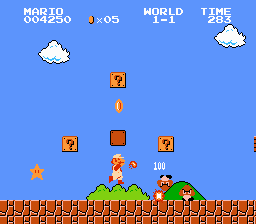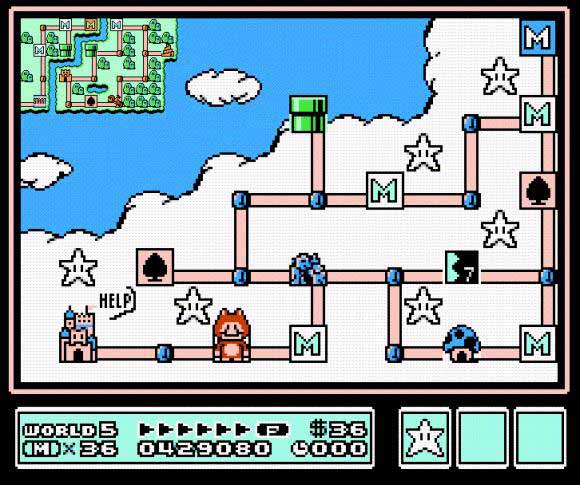Super Mario Bros
 I have already talked about this game at length so I am going to keep it short this time. Super Mario Bros is one of the first platformers ever, and easily the most polished. It used power ups to give the player new skills and abilites which has become a staple in all Mario games since (even the non-platform ones). It was one of the first games that had an extensive amount of hidden secrets and pathways (they appeared before in games but not to this extent). It had 32 levels, all of them were fairly unique from the last. Players could transverse the levels in many different ways, using different pathways and skipping certain levels. It not only brought in the idea of running through levels but also swimming, changing the gameplay. Being the first game in the series it introduced Bowser as the main antagonist and he has held that spot steadily since. It is, without a doubt, one of the most influencial games of all time. Every platforming game owes some of its design to Super Mario Bros.
I have already talked about this game at length so I am going to keep it short this time. Super Mario Bros is one of the first platformers ever, and easily the most polished. It used power ups to give the player new skills and abilites which has become a staple in all Mario games since (even the non-platform ones). It was one of the first games that had an extensive amount of hidden secrets and pathways (they appeared before in games but not to this extent). It had 32 levels, all of them were fairly unique from the last. Players could transverse the levels in many different ways, using different pathways and skipping certain levels. It not only brought in the idea of running through levels but also swimming, changing the gameplay. Being the first game in the series it introduced Bowser as the main antagonist and he has held that spot steadily since. It is, without a doubt, one of the most influencial games of all time. Every platforming game owes some of its design to Super Mario Bros.
Super Mario Bros 2 (Japan)
 Only in Japan was this true sequel released (only much later on Super Mario All-Stars did we get the game in the west). It is basically the original game only much harder. Jumps were trickier, enemies were more abundant, and the levels were designed in bizarre ways. The hidden pathways were still in this game along with warp pipes that let you skip levels. However, in Super Mario Bros 2 some pipes sent you backwards in the game, forcing you to play levels over again. Players had to be extremely careful while making decisions in this game. It was such a difficult game that it forced players to beat it 8 times before arriving in the true final level. Another strange turn of events happened if you used no warp pipes, as you would end up in World 9. World 9 was a truely bizzare world in which fire would fly underwater, Bowser was in the 9-3 not 9-4, and clouds were underwater. This game was the programmers having as much fun as possible with the Super Mario Bros engine.
Only in Japan was this true sequel released (only much later on Super Mario All-Stars did we get the game in the west). It is basically the original game only much harder. Jumps were trickier, enemies were more abundant, and the levels were designed in bizarre ways. The hidden pathways were still in this game along with warp pipes that let you skip levels. However, in Super Mario Bros 2 some pipes sent you backwards in the game, forcing you to play levels over again. Players had to be extremely careful while making decisions in this game. It was such a difficult game that it forced players to beat it 8 times before arriving in the true final level. Another strange turn of events happened if you used no warp pipes, as you would end up in World 9. World 9 was a truely bizzare world in which fire would fly underwater, Bowser was in the 9-3 not 9-4, and clouds were underwater. This game was the programmers having as much fun as possible with the Super Mario Bros engine.
One notable thing the game did change was Luigi. Luigi was now a selectable character (not forced on player 2), and had a new gameplay which set him apart from Mario. Luigi could jump higher and run faster, but was also less stable than Mario. The idea of Luigi playing this way has carried over in other games.
Super Mario 2 (USA) Many people already know the story behind this game but I will sum it up for those who don't know. A Japanese game called Doki Doki Panic was transformed into Super Mario Bros 2 for an American release. Nintendo felt the Japanese Super Mario Bros 2 was too difficult for the American gamers.
Many people already know the story behind this game but I will sum it up for those who don't know. A Japanese game called Doki Doki Panic was transformed into Super Mario Bros 2 for an American release. Nintendo felt the Japanese Super Mario Bros 2 was too difficult for the American gamers.
 However, even though it wasn't originally a Mario game it has become an important part of the evolution of the series. Series creator Shigeru Miyamoto did design Doki Doki Panic along with some of the team that made the Mario games. This is why the transformation wasn't so jarring. The enemies in Super Mario 2 (Shy guys, and Birdo) have carried over into more Mario games since. Doki Doki Panic had many levels and there was an ability to find warps and hidden pathways, which also translated perfectly for a Mario game.
However, even though it wasn't originally a Mario game it has become an important part of the evolution of the series. Series creator Shigeru Miyamoto did design Doki Doki Panic along with some of the team that made the Mario games. This is why the transformation wasn't so jarring. The enemies in Super Mario 2 (Shy guys, and Birdo) have carried over into more Mario games since. Doki Doki Panic had many levels and there was an ability to find warps and hidden pathways, which also translated perfectly for a Mario game.
 Super Mario 2 was unique for having 4 selectable characters (because Doki Doki Panic had 4 characters) and each of them fit naturally with estabilished characters. Luigi was a high jumper and very fast (much like in the Japanese Mario 2 but taken up a few notches), Princess could float through the air, Toad was a sturdy character who controlled well on ice, and Mario was the balanced character who was the jack of all trades and master of none. In Mario game offshoots (the Mario Sports series, Mario Kart, Super Smash Bros, and other random action games) these character traits have been used again and again.
Super Mario 2 was unique for having 4 selectable characters (because Doki Doki Panic had 4 characters) and each of them fit naturally with estabilished characters. Luigi was a high jumper and very fast (much like in the Japanese Mario 2 but taken up a few notches), Princess could float through the air, Toad was a sturdy character who controlled well on ice, and Mario was the balanced character who was the jack of all trades and master of none. In Mario game offshoots (the Mario Sports series, Mario Kart, Super Smash Bros, and other random action games) these character traits have been used again and again.
One change that has not stuck since was the way enemies were attacked. Rather than jumping on enemies and instantly killing them, you had to pick them up and throw them at another enemy. This was a fun and unique way to play but slowed the game down a bit. Mario games since have used quick attacks to finish off the enemy.
Super Mario Bros 3
 The first Mario sequel that was built completely new from the ground up. Many players still hold this game to be one of the greatest platformers of all time, if not one of the greatest games in general. Personally I cannot see much fault in this argument as it is the penacle of 2D platformers on the NES (which had a lot of great games in that genre).
The first Mario sequel that was built completely new from the ground up. Many players still hold this game to be one of the greatest platformers of all time, if not one of the greatest games in general. Personally I cannot see much fault in this argument as it is the penacle of 2D platformers on the NES (which had a lot of great games in that genre).
The game returned to its roots by just having Mario as player 1 and Luigi as player 2 both of whom played identical. It took the basic idea of the original Super Mario Bros and added better graphics, more power-ups, more enemies, bigger levels, more secrets, and more bosses. Everything was bigger and better. Instead of just facing Bowser at each castle you fought his children, each of which had their own personalities. This made for much more interesting boss battles. On top of that each boss resided on an airship which had the level moving while trying to move across it. Things like bullets and fireballs reacted realistically to the movement of the level and added an extra layer of gameplay. The standard castle levels were still found in this game as well and acting as mid-way points in the world. Each castle ended with a mini-boss.
 The best addition to the game was the overworld map. Each world had its own map and the player could move across it in many different ways. Some items collected in the levels could be used to break down walls in order to skip sections of the game and fast-track. It really showed the size, scale and interactivity of the game. Each world also had its own trait. There were the standard fare of levels (such as an ice world and a lava world) as well as some unique levels (a world filled with pipes that created a maze, and a world where everything was much bigger). Because of this massive variety in levels and the ability to move across the overworld in many different ways, the game never got stale.
The best addition to the game was the overworld map. Each world had its own map and the player could move across it in many different ways. Some items collected in the levels could be used to break down walls in order to skip sections of the game and fast-track. It really showed the size, scale and interactivity of the game. Each world also had its own trait. There were the standard fare of levels (such as an ice world and a lava world) as well as some unique levels (a world filled with pipes that created a maze, and a world where everything was much bigger). Because of this massive variety in levels and the ability to move across the overworld in many different ways, the game never got stale.Part 2 will continue next week and we will look at the SNES as well as the 3D Mario games. Come back friday for a new feature article.
No comments:
Post a Comment